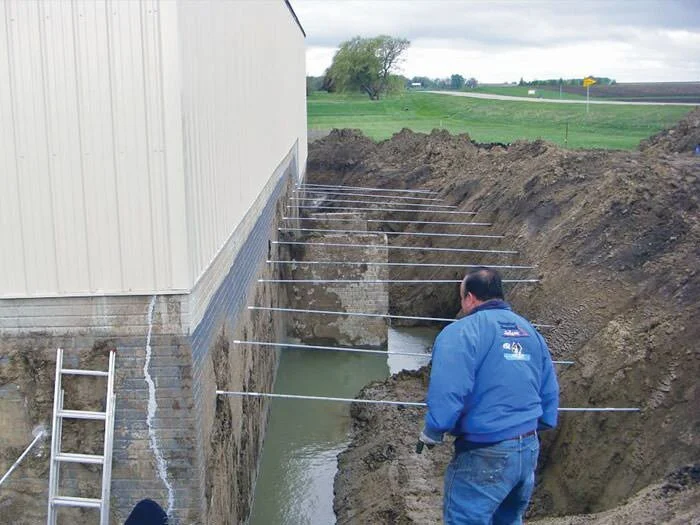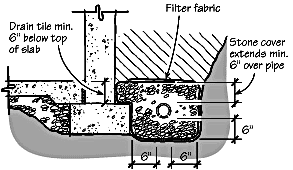SLAB HOMES
MOISTURE INTRUSION FACTORS
Concrete is a very hard surface, yet it is a sponge that soaks up from above and below.
It is 12-18% porous. Rain, irrigation and ground water soaks in from any direction.
Concrete and porous tile patios and walkways next to a house soak up moisture and hold that water next to a house, often contributing to moisture problems in slab homes.
All concrete soaks up water unless it’s been sealed.
Properly sealed; water beads up and runs off.
If it’s not beading up, it IS soaking in.
Not all slabs have moisture barriers underneath and these can become compromised over time.
Water that enters concrete is retained.
A continuous source of water creates water on top of water which adds weight pushing moisture through concrete and into the ground and slab floors.
Wet masonry transmits moisture up into surfaces that are in contact with it.
Moisture Meters
Meters can find moisture in flooring well before damage has occurred.
A good moisture meter measures up to 4” into wood and masonry surfaces.
This includes marble floors which can stain from below.
Unfortunately moisture damage to wood floors happens from the underside on up. By the time moisture is visible from the house, it can be too late to salvage.
Out of Sight—Out of Mind
Everyone is aware of rain, rivers, lakes and oceans since they are highly visible, but groundwater is out of sight and therefore out of mind.
La Cienega Boulevard, which travels from The City of Hawthorn to The Sunset Strip was named after Rancho Las Cienegas, Spanish translation: "The Ranch of The Swamps.” Today a high “water table” lies just below ground and, in many cases above ground in a crawlspace where it’s not obvious to home owners.
Approximately 30% of LA County’s water usage comes from naturally created underground pockets of fresh water. These ground water areas are called aquifers. There are 22 DWP regulated aquifers south of the San Gabriel Mountains. Each of which is thoroughly monitored by its own governing agency.
Basin: a depression in the Earth's surface, which is contributed to by multiple watersheds.
Watershed: an area or ridge of land that separates waters flowing to different rivers, basins, or seas.
Foundation walls can act as a barrier to the natural flow of groundwater from the hills to the valleys below, causing puddles and small swamps next to and hidden underneath structures.
This condition is more common than homeowners are aware.
WET SLAB SOLUTIONS
French Drains:
an underground drainage system.
Ideally french drains are installed around the outside perimeter of a structure, however retrofitting this system after a building has been landscaped and outfitted with planters, concrete walkways and patios can often be cost prohibitive.
Unfortunately french drains are often installed too high to be effective.
Place a french drain well below the floor of a home and the home, itself, will be protected from flooding.
This drawing shows a french drain 6” below a concrete floor, however, if there is a steep hillside near this building the water below this drain will enter the footing and through capillary action can climb up the concrete wall.
Capillary Action: the ability of a liquid to defy gravity in masonry.
INTERIOR SOLUTIONS
Ideally water is kept out of a building from the outside. When this is impractical interior solutions are available.
sump: a manufactured pit in which liquid collects. This liquid is pumped out to a safe location.
Most commercially available sumps are non-permeable. They are manufactured in a way to collect surface water off a concrete floor or to catch water from a french drain.
Masters of Moisture has invented an ideal “soaking sump system” that allows water in while filtering out dirt and preventing penetration from roots.
Interior concrete and block walls, such as the average basement wall, can be treated to repel hydrostatic pressure. They must first be stripped back to bare concrete. Then one of several special materials is applied that soaks into concrete and crystalizes.
Don’t be fooled by paint-on materials that claim to repel hydrostatic pressure such as Drylok. It covers the evidence of moisture intrusion for a short period of time and then bubbles and peels in a disappointingly few weeks.
Applying materials to repel hydrostatic pressure must be done precisely and with the most appropriate materials for the condition.
Professionally applied amateur materials or applications of professional materials by an amateur will not work.
These will need to be removed before one can do the job effectively with professional materials.
Value Engineering
One or more of the above solutions is needed to solve a slab being saturated with moisture. These solutions should be professionally designed to resolve a property’s unique circumstances.
We Provide:
Free advice
Inspections
Reports
Estimates
Professionally Implemented Solutions
Recommendations to other skilled trade persons.














